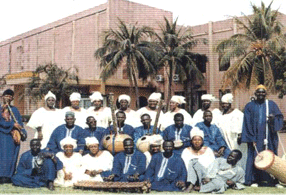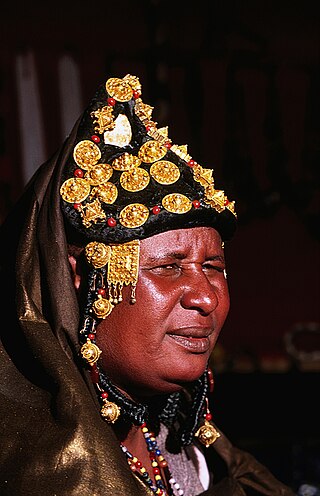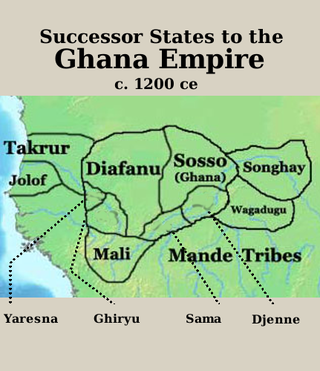Related Research Articles

The music of Mali is, like that of most West African nations, ethnically diverse, but one influence predominates: that of the ancient Mali Empire of the Mandinka. Mande people make up around 50% of Mali's population; other ethnic groups include the Fula (17%), Gur-speakers 12%, Songhai people (6%), Tuareg and Moors (10%).
Sundiata Keita was a prince and founder of the Mali Empire. He was also the great-uncle of the Malian ruler Mansa Musa, who is usually regarded as the wealthiest person of all time, although there are no reliable ways to accurately calculate his wealth.

The Songhai people are an ethnolinguistic group in West Africa who speak the various Songhai languages. Their history and lingua franca is linked to the Songhai Empire which dominated the western Sahel in the 15th and 16th century. Predominantly adherents of Islam, the Songhai are primarily located in Niger and Mali. Historically, the term "Songhai" did not denote an ethnic or linguistic identity but referred to the ruling caste of the Songhay Empire known as the Songhaiborai. However, the correct term used to refer to this group of people collectively by the natives is "Ayneha". Although some speakers in Mali have also adopted the name Songhay as an ethnic designation, other Songhay-speaking groups identify themselves by other ethnic terms such as Zarma or Isawaghen. The dialect of Koyraboro Senni spoken in Gao is unintelligible to speakers of the Zarma dialect of Niger, according to at least one report. The Songhay languages are commonly taken to be Nilo-Saharan but this classification remains controversial: Dimmendaal (2008) believes that for now it is best considered an independent language family.

Askia Muhammad Ture I (1443–1538), born Muhammad ibn Abi Bakr al-Turi or Muhammad Ture, was the first ruler of the Askia dynasty of the Songhai Empire, reigning from 1493 to 1528. He is also known as Askia the Great, and his name in modern Songhai is Mamar Kassey. Askia Muhammad strengthened his empire and made it the largest empire in West Africa's history. At its peak under his reign, the Songhai Empire encompassed the Hausa states as far as Kano and much of the territory that had belonged to the Songhai empire in the east. His policies resulted in a rapid expansion of trade with Europe and Asia, the creation of many schools, and the establishment of Islam as an integral part of the empire.
The Mandé peoples are an ethnolinguistic grouping of native African ethnic groups who speak Mande languages. Various Mandé-speaking ethnic groups are found particularly in the western regions of West Africa. The Mandé languages are divided into two primary groups: East Mandé and West Mandé.
Sunjata is an epic poem of the Malinke people that tells the story of the hero Sundiata Keita, the founder of the Mali Empire. The epic is an instance of oral tradition, going back to the 13th century and narrated by generations of jelis (griots). There is no single or authoritative version. Material pertaining to the epic first began to be collected during the early 20th century in French Sudan, notably by the French elite school École William Ponty, resulting in the "modern" version of the tale as considered standard today, based on the oral account by Djeli Mamoudou Kouyate, a jeli or traditional oral historian, translated into French by Djibril Tamsir Niane in 1960.
Caste systems in Africa are a form of social stratification found in numerous ethnic groups, found in over fifteen countries, particularly in the Sahel, West Africa, and North Africa. These caste systems feature endogamy, hierarchical status, inherited occupation, membership by birth, pollution concepts and restraints on commensality.
Say (Saayi) is a town in southwest Niger, situated on the Niger River. It is the capital of the Say Department in the Tillabéri Region. Say was a small Songhai town prior to the arrival of the Fulani marabout Alfa Mohamed Diobo in the nineteenth century who converted the town to a center for Islamic learning and established the Emirate of Say. The municipality has 58,290 inhabitants, and its economy is dominated by agriculture, herding and small trade. Today, the inhabitants of Say are mostly Peulh, Songhai and Zarma.

The Zarma people are an ethnic group predominantly found in westernmost Niger. They are also found in significant numbers in the adjacent areas of Nigeria and Benin, along with smaller numbers in Burkina Faso, Ivory Coast, Ghana, Togo, and Sudan. In Niger, the Zarma are often considered by outsiders to be of the same ethnicity as the neighboring Songhaiborai, although the two groups claim differences, having different histories and speaking different dialects. They are sometimes lumped together as the Zarma-Songhay or Songhay-Zarma.

Pre-imperial Mali refers to the period of history before the establishment of the Mali Empire, an African empire located mostly in present-day Mali, in c. 1235.

Songhoyboro Ciine or Songhay Ciiné is an upriver dialect of the southern Songhay dialect of Niger. It is spoken mostly in the northwestern corner of Niger's Tillaberi region, an area known as Songhay: from Gorouol, a border town with Mali, down to the towns of Tera, Anzourou, Namari Goungou and Say.
Tongo Tongo is a village in the rural commune (municipality) of Tondikiwindi, Ouallam Department, Tillabéri Region in southwestern Niger, 174 km north of the nation's capital Niamey and 28 km south of the border with Mali. The village has about 160-170 huts/dwellings, irregularly clustered. There are no roads, only trails that connect to nearby villages such as Siwili, Firo, Sabara Bangou, Sinka Koira, Gollo, Gouré Tonndi, Kokorobé Koukou, and Zerma Daré.
Sabara Bangou is a village in the north of the rural commune (municipality) of Tondikiwindi, Ouallam Department, Tillabéri Region in southwestern Niger, 180 km north of the nation's capital Niamey and 22 km south of the border with Mali.
The village has about 70-75 huts/dwellings, irregularly clustered. There are no roads, just trails that connect to nearby villages such as Soufaré, Tiloa, Diéno Koara, Tongo Tongo, Sinka Koira, Gollo, Gouré Tondi and Kokorobé Koukou .
The population of the commune consists for 99% of the Zarma people. Most of them own cattle, sheep, goats and dromedaries, renting them out to the Fulani people or Tuareg people for tending. Though arable land is rare and poor, there is also some agriculture, mostly millet and sorghum. The area is part of the Sahel and consists of a vast expanse of plateaux and hills. The physical environment is in an advanced state of degradation caused by habitat destruction, poaching, and by the viccisitudes of the local climate.
Abdoulaye Boureima, popularly known as Mali Yaro, is a Nigerien Songhai musician. He began his artistic career as a young goumbé player. Then, together with friends, formed in 1996 a music group, the Goumbé Stars. Mali Yaro songs were about love, rejoicing and a call for cohesion. Mali Yaro has produced 9 albums.

The Songhai, ) is an area in the northwestern corner of Niger's Tillabéri Region populated mainly by the Songhaiborai. It is considered the heartland of the Songhai people and the sanctuary of their ancient pantheon and priestly class and the place in which the original lineage of the Sonni dynasty retreated after the coup d'etat of 1493 creating a secret society of magicians, the Sohance.
The Emirate of Say was an Islamic state founded in 1825 by Alfa Mohamed Diobo, a Qadiriyya Sufi leader who came to Say from Djenné (Mali) in 1810. Though Diobo was no conqueror, his control over Say was ensured by both his clerical renown and the diplomatic protection of the Sokoto Empire, also founded by a Fulani Qadiriyya Sufi cleric, Usman Dan Fodio.
The Wogo people are a small subgroup of the broader Songhai people. They are found primarily in Niger and Mali on the banks and islands of the Niger river, a territory they share with the Zarma, the Kurtey and the Songhay. The main Wogo communities are found on the islands in the Tillabery region of Niger with the largest being Ayorou in Niger and Boura in Mali. They speak the Wogo Ciine songhay dialect.

The Songhaiborai are a distinct subgroup within the larger Songhai ethnolinguistic family. Residing predominantly in Niger's Songhai region, Northern Mali, and a minority presence in Burkina Faso. Notably, they trace their lineage to the ruling dynasties of the ancient Songhai Empire.
Sogolon Wulen Condé of Dò ni Kiri, commonly known as Sogolon Condé, was a 13th-century princess of Imperial Mali, and one of the prominent women portrayed in the Epic of Sundiata. Her trials and tribulations are well preserved in the epic. She was the second wife of Faama (King) Naré Maghann Konaté, and mother of Mansa Sundiata Keita, founder of the Mali Empire in the 13th century. According to Bamba Suso and Banna Kanute, Sogolong's father was Sankarang Madiba Konte, also known as Faa Ganda, a descendant of Khulubu Konte. In the epic, Sogolon is portrayed as the daughter of the "buffalo woman" –so-called because of her "ugliness" and hunchback, and so was Sogolong. The griots of Guinea refer to Sogolon as the younger sister of Do Kamissa. In many parts of the Senegambia region, and Mali, Sogolon is regarded as her daughter. As well as her physical deformities and "ugliness", Sogolon also gave birth to a disabled son (Sundiata), and was ridiculed for that. Following the death of her husband Naré Maghann Konaté, her co-wife, the politically ambitious Sassouma Bereté, Naré Maghann's first wife along with their first son Dankaran Toumani Keïta, plotted against Sogolon and her children, including assassination attempts on their lives. Fearing that the new King Dankaran and his mother Sassouma could inflict harm upon her and her children, Sogolon went into exile with her children to protect them from harm. Due to the power and influence of Dankaran and his mother, Sogolon and her children were refused asylum by many states within the Ghana Empire they traversed seeking protection. She was eventually granted asylum by the King of Mema Mansa Farin Tunkara. In Mema, Sogolon encouraged his disabled son Sundiata to fulfill his destiny, and return to Mali (Manden) and take the throne.
The Tchoma Bangou and Zaroumdareye massacres took place on January 2, 2021, when 105 people were killed and 75 injured in attacks by Islamic State in the Greater Sahara on the villages of Tchoma Bangou and Zaroumdareye in Tondikiwindi, Ouallam Department, Niger. The massacres were one of the deadliest events in Nigerien history.
References
- ↑ Johnson, Sir, John (1997), Oral Epics from Africa: Vibrant Voices from a Vast Continent, Indiana University Press, ISBN 0253211107 , retrieved 2021-03-17
- ↑ Idrissa, Abdourahmane (2020), Historical Dictionary of Niger By Abdourahmane Idrissa, p. 506 "Zarmaganda", ISBN 9781538120156 , retrieved 2021-04-14
- ↑ A. Austen, Ralph (1999), In Search of Sunjata: The Mande Oral Epic as History, Literature and Performance, p. 114, ISBN 0253334527 , retrieved 2021-06-05
- ↑ Hassane, Daouda (2019), Sargane (Ouallam) : Sur La Tombe De Mali Béro, L'ancêtre Des Zarma , retrieved 2021-03-17
- ↑ Lange, Dierk (2004), Ancient Kingdoms of West Africa: African-centred and Canaanite-Israelite, p. 473, ISBN 9783897541153 , retrieved 2021-04-14
- ↑ A. Austen, Ralph (1999), In Search of Sunjata: The Mande Oral Epic as History, Literature and Performance, p. 124, ISBN 0253334527 , retrieved 2021-04-14